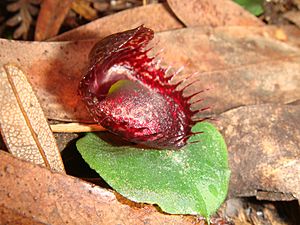Fringed helmet orchid facts for kids
Quick facts for kids Fringed helmet orchid |
|
|---|---|
 |
|
| Corybas fimbriatus at Coles Bay | |
| Scientific classification | |
| Synonyms | |
|
The Fringed Helmet Orchid, also known as Corybas fimbriatus, is a special kind of orchid that grows only in eastern Australia. It gets its name "fringed" because of the cool, frilly edges on its flower. This orchid has a unique look with a broad, round leaf and a beautiful dark reddish-purple or crimson flower that has see-through spots. It looks a bit like another orchid, C. hispidus, but you can tell them apart because the Fringed Helmet Orchid's main petal (called the labellum) doesn't have a creamy-white center or bristly hairs.
Contents
What the Fringed Helmet Orchid Looks Like
The Fringed Helmet Orchid is a ground-dwelling plant, meaning it grows in the soil, not on other plants. It's a perennial herb, which means it lives for more than two years and has soft stems instead of woody ones. This plant also loses its leaves every year, which is called being deciduous.
It has a single leaf that is broad and shaped like an egg or is round. This leaf is about 15 to 40 millimeters (0.6 to 1.6 inches) long and wide. The top of the leaf is dark green, and the underside is a shiny silvery green.
Each plant grows one flower, which is a dark reddish-purple or crimson color with parts that you can see through. The top part of the flower, called the dorsal sepal, is shaped like a cup and is about 20 to 25 millimeters (0.8 to 1 inch) long and 15 to 18 millimeters (0.6 to 0.7 inches) wide. It forms a kind of hood over the labellum, which is the orchid's special lip-like petal.
The side sepals are thin and about 5 millimeters (0.2 inches) long, usually joined together. The other petals are also thin and about 4 millimeters (0.16 inches) long. The labellum itself is about 15 millimeters (0.6 inches) long and has a clear bump in the middle. Its edges have many long, narrow teeth, giving it a "fringed" look. You can see these orchids flowering from May to August.
How the Fringed Helmet Orchid Got Its Name
The Fringed Helmet Orchid was first officially described in 1810 by a botanist named Robert Brown. He first called it Corysanthes fimbriatus. He wrote about it in his book, Prodromus Florae Novae Hollandiae et Insulae Van Diemen.
Later, in 1871, another botanist named Heinrich Gustav Reichenbach changed its name to Corybas fimbriatus. The second part of its scientific name, fimbriatus, comes from a Latin word. It means "fringed" or "fibrous," which perfectly describes the frilly edges of its flower.
Where the Fringed Helmet Orchid Lives
The Fringed Helmet Orchid is quite common and can be found in many places. It grows in open, shrubby areas called heathland and in moist forests.
You can find this orchid in Queensland, starting from the town of Gympie and going south. It also lives along the coast and in the mountain ranges of New South Wales, in southeastern Victoria, and across Tasmania. There's even a small group of them living far away on the Atherton Tableland in Queensland.
Growing Fringed Helmet Orchids
Even though most people who grow orchids are special enthusiasts, the Fringed Helmet Orchid is actually easier to grow than other orchids in the same group (genus).
If you want to grow one, it needs soil that drains water well, like a sandy mix. It also needs good air circulation around it and about half a day of sunlight.

